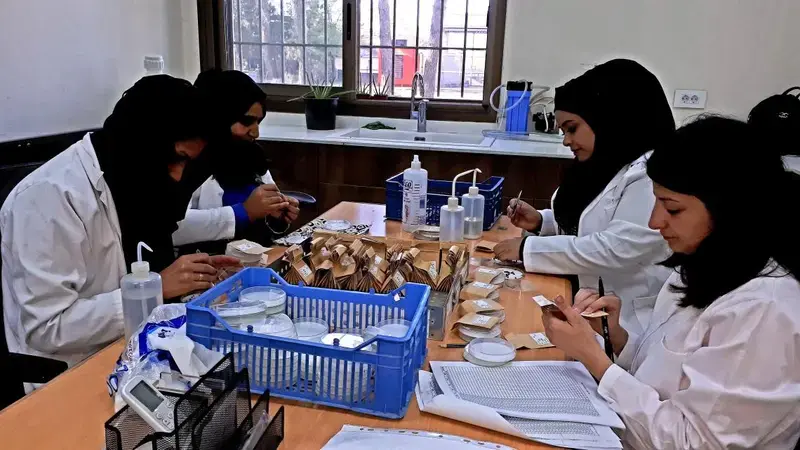Genetic resources to fight climate change

Agricultural biodiversity – or agrobiodiversity, which refers to genetic resources related to food and feed crops, and animals such as sheep and goats – in drylands is vital to global food security. This is because the non-tropical dry areas cover more than 40 percent of the world’s land surface and are highly vulnerable to climate change. They are also home to roughly 2.5 billion people, about one-third of whom depend on farming for their livelihood.
Ideally, preserving genetic diversity in crop plants happens in the wild or on farm. But as crops suffer from extreme weather conditions and emergence of invasive species, and landraces and wild relatives are being replaced by uniform high-yielding varieties, genebanks have become an integral part of plant conservation.
In a recent visit to the genebanks in ICARDA and the Lebanese Agricultural Research Institute (LARI) in Terbol, Lebanon, ICARDA’s board members learned about the genebanks’ best practices for regeneration, characterization, ex situ conservation, documentation, and distribution of seed and rhizobium genetic resources.
“The diversity stored in ICARDA and LARI genebanks are a wealth of public goods that can be used toward climate change adaptation, better nutrition, and less food loss,” said Ruth Haug, professor of development studies at the Norwegian University of Life Sciences and an ICARDA board member. LARI, one of ICARDA’s national research partners, has hosted ICARDA in Terbol and Kfardan research stations since 1978.
“We are seeing a trend of decreasing number of crops and crop varieties, so it’s really reassuring to know that ICARDA and national partners like LARI have been able to protect and manage valuable genetic resources in such a good way and under very challenging circumstances,” Haug added.
ICARDA’s genebank holdings are a testament to its success. Currently, it has more than 157,000 samples of major winter cereals, food legumes, forage and rangeland species drawn from the heart of drylands agrobiodiversity – from the ‘Fertile Crescent’ in Western Asia and the Abyssinian highlands in Ethiopia, the Mediterranean area and the Caucasus, where earliest known crop domestication practices were first recorded. Many plants are now extinct in their natural habitats.
In Terbol, the largest of the four research stations in Lebanon, ICARDA scientists mine genes and add novel diversity to develop superior germplasm. They are not only conserving seeds for the future, but also providing improved and resilient cultivars and livestock that can withstand climate and market-related challenges – this includes traits of heat, drought, cold and salinity tolerance, disease and pest resistance, nutritional attributes, and water-use efficiency.
ICARDA’s partnership with LARI has had rich results, including 24 high-yielding varieties of wheat, barley, lentil, chickpea, faba bean, and forage legumes. Three ICARDA durum wheat varieties released in 2013 went through multiplication processes at LARI. This resulted in the generation of 8,000 tons of certified seeds, helping the country become self-sufficient in wheat-seed production.
The scientists are about to release two new superior genotypes based on the durum wheat program. Together, they have also generated 1,000 tons of certified barley seeds.
Another major activity is the multiplication, preparation, and shipment of improved varieties from the international nurseries at the American University of Beirut’s Advancing Research Enabling Communities Center (AREC), another partner. The shipments represent the very best candidate varieties ICARDA breeders have identified. The nurseries have provided varieties to breeders in more than 50 countries. The breeders can identify and release superior varieties for their region, select and evaluate materials, and provide feedback.
“The challenge now is to encourage more farmers to adopt these new varieties,” said Paul Struik, chairman of ICARDA board’s program committee and head of the Center for Crop Systems Analysis at the Wageningen University in the Netherlands. “Farmers need to demand more action from national seed systems and be involved in seed distribution.”
The genetic resources work also acts as insurance policy, particularly in regions like MENA that suffer from war or political unrest. For example, when scientists in Afghanistan and Iraq lost their germplasm during the conflict, they received from ICARDA genebank the germplasm they had safely stored previously. That seed is now helping these states to regrow their agricultural economies.
ICARDA genebank was established in 1985 in Tel Hadya, Syria. In 2012, ICARDA relocated its gene bank activities to Lebanon and Morocco, where it has established gene bank facilities and conducts intensive regeneration and characterization for reconstruction of active and base collections. The successful decentralization and reconstruction of its holdings can be attributed to its most precious resource – its staff, some of whom have worked at the gene bank for decades and have transferred their knowledge to younger colleagues.
